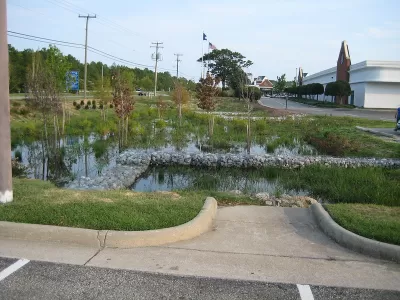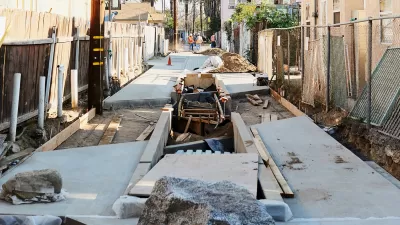How ‘sponge cities’ can protect residents and conserve water.

In an opinion piece in Next City, Franco Montalto touts the benefits of the ‘sponge city’ approach to flood mitigation that more and more cities are undertaking to protect their residents and infrastructure from catastrophic floods.
According to Montalto, “If this concept is to evolve into the new standard for urban design, city officials and developers will need to find ways to scale up and accelerate this work.”
Montalto explains that most U.S. stormwater management systems are not designed to handle all of the runoff created during a large storm. Now, cities are shifting to ‘green infrastructure’ to manage stormwater and direct it back into the ground rather than shuttling it out to rivers or oceans. This comes with its own challenges. “In the best cases, green infrastructure has been installed on publicly owned land and required on new or redesigned large-scale developments. It has proved much more challenging to incorporate green infrastructure on smaller, privately owned land parcels, which collectively make up a significant percentage of urban watershed areas.” In some areas, stormwater management is not even required as part of new development.
Montalto outlines some strategies cities can use to prevent flooding that include permeable asphalt, green roofs, rain gardens, and parks and green spaces designed to flood safely. Montalto also suggests ways to fund these efforts, pointing to collaborations between cities and nonprofit organizations as one option. “Cities could also offer incentives for retrofitting and scaling up existing stormwater management systems on private land. A trading system could be set up to sell the residual capacity to nearby property owners who lack onsite stormwater management opportunities.”
FULL STORY: Sponge Cities Are the Future of Urban Flood Mitigation

Planetizen Federal Action Tracker
A weekly monitor of how Trump’s orders and actions are impacting planners and planning in America.

Maui's Vacation Rental Debate Turns Ugly
Verbal attacks, misinformation campaigns and fistfights plague a high-stakes debate to convert thousands of vacation rentals into long-term housing.

Restaurant Patios Were a Pandemic Win — Why Were They so Hard to Keep?
Social distancing requirements and changes in travel patterns prompted cities to pilot new uses for street and sidewalk space. Then it got complicated.

In California Battle of Housing vs. Environment, Housing Just Won
A new state law significantly limits the power of CEQA, an environmental review law that served as a powerful tool for blocking new development.

Boulder Eliminates Parking Minimums Citywide
Officials estimate the cost of building a single underground parking space at up to $100,000.

Orange County, Florida Adopts Largest US “Sprawl Repair” Code
The ‘Orange Code’ seeks to rectify decades of sprawl-inducing, car-oriented development.
Urban Design for Planners 1: Software Tools
This six-course series explores essential urban design concepts using open source software and equips planners with the tools they need to participate fully in the urban design process.
Planning for Universal Design
Learn the tools for implementing Universal Design in planning regulations.
Heyer Gruel & Associates PA
JM Goldson LLC
Custer County Colorado
City of Camden Redevelopment Agency
City of Astoria
Transportation Research & Education Center (TREC) at Portland State University
Jefferson Parish Government
Camden Redevelopment Agency
City of Claremont




























